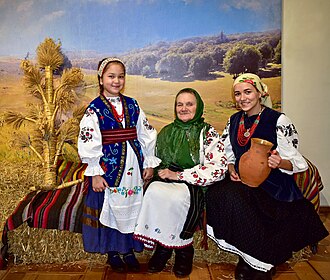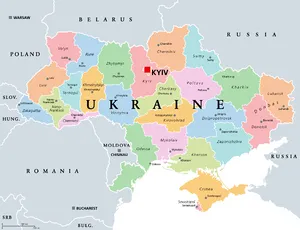The number of Ukrainians living abroad in 2020 was estimated to be about 6 million, according to United Nations figures. That makes Ukrainians the second largest group from eastern Europe, only second to Russians, who are living worldwide. [1] Today, Canada claims to have the largest population of Ukrainians in the world. [2]
Ukrainians seeking new opportunities in another land has been a trend since the late 19th century. The most recent wave of Ukrainians emigrants is the result of the Russian war in Ukraine that started with Russia invading Ukraine in February 2022. Almost 6.2 million Ukrainian emigrants left their homes to seek safety from the war. The vast majority of Ukrainian emigrants (5.8 million) from the newest wave are living in Europe. [3]
Research your ancestors on MyHeritage
First wave (late 19th century- early 20th century)First wave (late 19th century- early 20th century)

The struggles of living in Galicia, then part of the Austro-Hungarian Empire, led to the first wave of Ukrainians leaving their homeland for better lives. It is estimated that 500,000 people relocated to the United States, Canada, Brazil and Argentina. Also, 2 million people living in eastern Ukraine moved to the Siberian, Altai and the Far East areas of Russia. [4]
Ukrainians from the regions of Lemko, Carpatho-Ruthenia and Galicia first came in large groups to the USA in the 1870s. Estimating how many Ukrainian immigrants came to the USA is difficult to determine because immigrants were identified as Russians, Poles, Hungarians and Austrians. [5]
Those who chose Canada as their new homeland were enticed by the government's offer of free land in Canada's prairies. The invitation was offered in 1897 by Cliffford Sifton, the federal minister of the interior. [2]
Second wave (1920s-1930s)Second wave (1920s-1930s)
The collectivization of Ukraine's rural area and the death and lack of food that were associated with the famine called Holodomor brought about another large movement of Ukrainians leaving their homeland. [3] Another reason Ukrainians were looking for a new place to call home was the problem of persecution from government officials. Unlike the first wave of emigrants, these emigrants were typically literate and very apprised of having Ukrainian heritage. [6]
Other Ukrainians also were forced to leave their country. The Soviet government expelled 1.2 million people in western Ukraine and relocated them to the eastern area of the USSR from 1939 to 1941. That relocated populated included 400,000 Ukrainians. [4]
Third wave (World War II- post war years)Third wave (World War II- post war years)
Many Ukrainians were taken by force to work for the Germans outside of Ukraine during WWII. When the war ended, some Ukrainians (about 85,000) objected to returning to the Soviet Union and immigrated to the United States. [4] It is estimated that 2.2 million Ukrainians were taken as laborers for the Germans and most were forcibly returned to the Soviet Union. [7]
Those who chose the United States as their new homeland typically came from displaced persons camps in Germany and Austria. The majority of Ukrainians who arrived in the United States had roots from western Ukraine, in addition to being mostly literate and having completed some higher education at a higher rate than compared to the previous waves. [6]
Displaced Ukrainians also arrived in Canada but in much smaller numbers. By 1952, about 30,000 Ukrainians arrived in Canada. [8]
Fourth wave (breakup of the former USSR- post independence years)Fourth wave (breakup of the former USSR- post independence years)
The economy of Ukraine crashed once the former USSR ceased to exist in 1991, leading to political and economic struggles in the newly independent country. It is estimated that after 2001 about 6 million Ukrainians left their country. Then, a large group of migrant workers (1.3 million) emigrated during the years of 2015-2017. [4]
In the earlier years of the fourth wave, many emigrating Ukrainians (85 percent) chose another former USSR country. More than 3 million Ukrainians (64 percent) selected Russia as their new homeland. By 2017, the trend of relocating to former USSR countries changed for a different direction. Ukrainians chose Europe (western and central countries), Australia, United States and Canada. About 700,000 Ukrainian migrants were in those areas of the world in 1991 but statistics show at least 2.5 million Ukrainians were located in those areas of the world by 2017. [4]
Fifth wave (Russian war with Ukraine 2022-current years)Fifth wave (Russian war with Ukraine 2022-current years)

Millions of Ukrainians left their homeland due to Russia's invasion, with time telling how many will return to Ukraine. The majority of Ukrainians left for Poland, with 5.4 million fleeing to their close western neighbor. The other nearby countries that Ukrainians chose have been Hungary (1.2 million), Moldova (573,000), Romania (1 million) and Slovakia (690,000). [9]
Ukrainians also sought refuge in North America, especially Canada. More than 1 million Ukrainians applied for permission to enter Canada, which approved more than 650,000 applicants. (8) Meanwhile in the United States, the government promised to welcome 100,000 Ukrainian refugees in April 2022, however only about 2,400 Ukrainians have been approved for arrival into the USA. [10]
The relationship between Ukraine and Russia became very strained when Russia claimed the Crimean Peninsula as a part of its country under an illegal annexation and began a campaign to take over areas in eastern Ukraine by supporting separatists who are pro-Russia in 2014. More than 3,000 people died and 850,000 people left their homes, in addition to about 3 million needing aid to survive in the fight over eastern Ukraine during the eight years before Russia declared war on Ukraine. [11]
Russian officials have been upset that Ukrainian officials have been developing closer relationships with the European Union and NATO. Months into the war, the European Union approved Ukraine as a candidate of formal membership but Ukraine has yet to meet the seven conditions needed to start negotiations for a European Union membership. As of June 2023, Ukraine only has met two of those conditions. [12]
See also:
Search for records in UkraineSearch for records in Ukraine
Explore more about Ukrainian emigrationExplore more about Ukrainian emigration
- Ukrainian records at MyHeritage
- Immigration & Travel records collection at MyHeritage
- Emigration page of the Encyclopedia of Ukraine
- Ukrainian Americans- History, Modern Era- A detailed page from Every Culture with information on media, museums and cultural centers for Ukrainians.
References
- ↑ International Organization for Migration, World Migration Report 2022, https://publications.iom.int/system/files/pdf/WMR-2022.pdf
- ↑ 2.0 2.1 Canada is facing the largest wave of Ukrainian immigration ever, New Canadian Media, Yuriy Umansky, April 28, 2023, https://newcanadianmedia.ca/many-ukrainians-have-applied-for-a-visa-to-come-to-canada-but-many-of-them-choose-not-to-come/
- ↑ 3.0 3.1 United Nations High Commissioner for Refugees, Operational Data Portal, Ukraine Refugee Situation, https://data2.unhcr.org/en/situations/ukraine
- ↑ 4.0 4.1 4.2 4.3 4.4 Ukraine- Emigration and Displacement in Past and Present, Iryna Lapshyn, July 8, 2022, Bundeszentrale für politische Bildung, https://www.bpb.de/themen/migration-integration/laenderprofile/english-version-country-profiles/510002/ukraine-emigration-and-displacement-in-past-and-present/
- ↑ Ukrainians, Case Western University, https://case.edu/ech/articles/u/ukrainians
- ↑ 6.0 6.1 United States of America, Internet Encyclopedia of Ukraine, https://www.encyclopediaofukraine.com/display.asp?linkpath=pages%5CU%5CN%5CUnitedStatesofAmerica.htm
- ↑ Ostarbeiter, Internet Encyclopedia of Ukraine, https://www.encyclopediaofukraine.com/display.asp?linkpath=pages%5CO%5CS%5COstarbeiterIT.htm
- ↑ Ukraine and Canada share a lived history, Constantine Passaris, Troy Media Newswire, Feb 21, 2023, https://troymedia.com/lifestyle/ukrainian-immigration-has-profoundly-effect-canada/
- ↑ "Ukrainian refugees: Challenges in a welcoming Europe,” Omer Karasapan, October 14, 2022, The Brookings Institution, https://www.brookings.edu/articles/ukrainian-refugees-challenges-in-a-welcoming-europe/
- ↑ Statista, Monthly intake of refugees from Ukraine to the United States from October 2021 to July 2023, Aug. 14, 2023, https://www.statista.com/statistics/1310881/refugees-ukraine-united-states-2022/
- ↑ Ukraine Crisis, International Rescue Committee, https://www.rescue.org/topic/ukraine-crisis
- ↑ Ukraine meets two of seven conditions to launch EU membership talks, Gabriela Baczynska, June 20, 2023, Reuters, https://www.reuters.com/world/europe/ukraine-meets-2-7-conditions-launch-eu-membership-talks-sources-2023-06-19/

